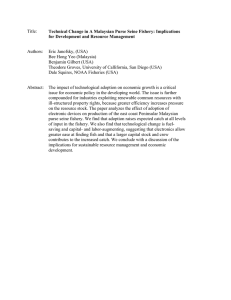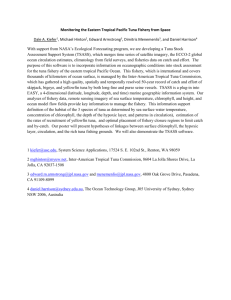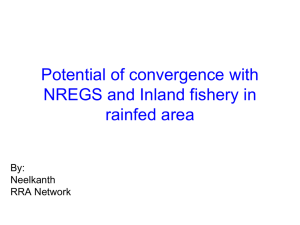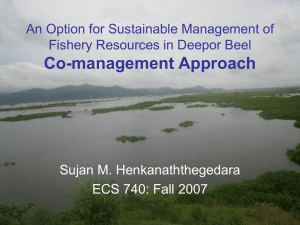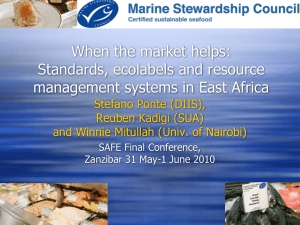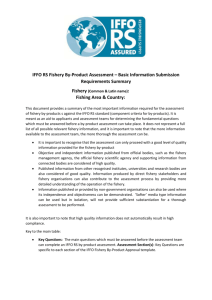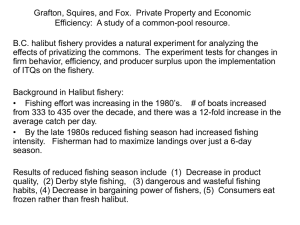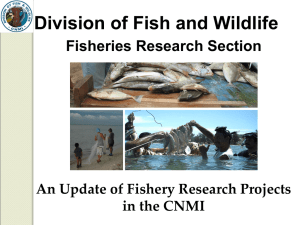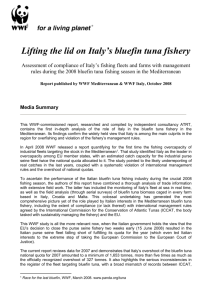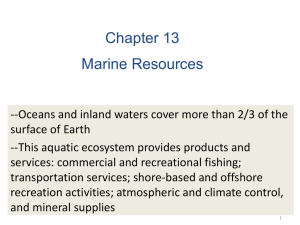the western central pacific purse seine fishery
advertisement
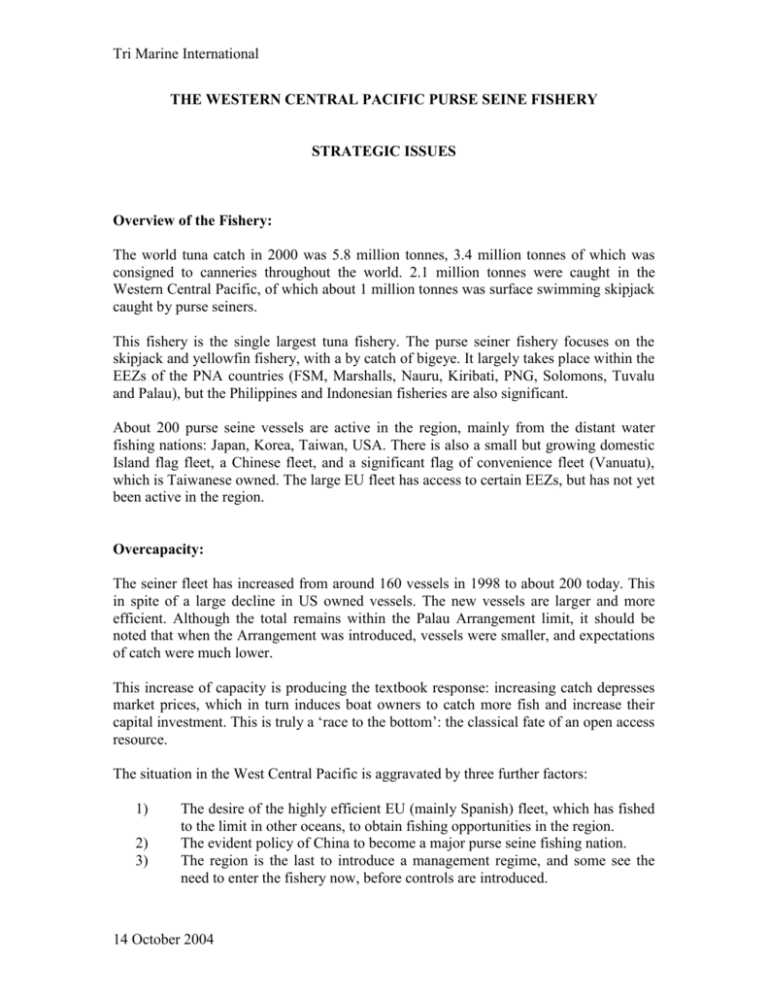
Tri Marine International THE WESTERN CENTRAL PACIFIC PURSE SEINE FISHERY STRATEGIC ISSUES Overview of the Fishery: The world tuna catch in 2000 was 5.8 million tonnes, 3.4 million tonnes of which was consigned to canneries throughout the world. 2.1 million tonnes were caught in the Western Central Pacific, of which about 1 million tonnes was surface swimming skipjack caught by purse seiners. This fishery is the single largest tuna fishery. The purse seiner fishery focuses on the skipjack and yellowfin fishery, with a by catch of bigeye. It largely takes place within the EEZs of the PNA countries (FSM, Marshalls, Nauru, Kiribati, PNG, Solomons, Tuvalu and Palau), but the Philippines and Indonesian fisheries are also significant. About 200 purse seine vessels are active in the region, mainly from the distant water fishing nations: Japan, Korea, Taiwan, USA. There is also a small but growing domestic Island flag fleet, a Chinese fleet, and a significant flag of convenience fleet (Vanuatu), which is Taiwanese owned. The large EU fleet has access to certain EEZs, but has not yet been active in the region. Overcapacity: The seiner fleet has increased from around 160 vessels in 1998 to about 200 today. This in spite of a large decline in US owned vessels. The new vessels are larger and more efficient. Although the total remains within the Palau Arrangement limit, it should be noted that when the Arrangement was introduced, vessels were smaller, and expectations of catch were much lower. This increase of capacity is producing the textbook response: increasing catch depresses market prices, which in turn induces boat owners to catch more fish and increase their capital investment. This is truly a ‘race to the bottom’: the classical fate of an open access resource. The situation in the West Central Pacific is aggravated by three further factors: 1) 2) 3) The desire of the highly efficient EU (mainly Spanish) fleet, which has fished to the limit in other oceans, to obtain fishing opportunities in the region. The evident policy of China to become a major purse seine fishing nation. The region is the last to introduce a management regime, and some see the need to enter the fishery now, before controls are introduced. 14 October 2004 Tri Marine International The Palau Arrangement is in clear danger of being breached, as the number of seiners given access relentlessly increases. At the same time, the number of domestic vessels permitted is fixed, and many of the ‘domestic’ slots have been taken by flag of convenience vessels. The response of the Palau Arrangement countries has been to re-cast the Arrangement criteria – not only to resolve the problem of increasing effort, but also to increase license fee revenue. The result is the proposed Vessel Day Scheme, which will limit the number of days fished in the region by purse seine vessels. Whilst having some theoretical attractions, many of us fear that the result will be a continuing increase of effort, as the fleet grows, and finds ways of accommodating itself within the new regulations. The means of monitoring days fished is by no means assured, but the ingenuity of boat owners is. The burdens of monitoring and control, not to mention sea day management, placed on fishery administrations will be significant. If the present effort is not reduced, Island State revenues are unlikely to increase. Overfishing: The largest component of the purse seine catch is skipjack. There is no scientific opinion that the skipjack resource is presently even near to overfishing. However, the yellowfin resource has reached maximum exploitation, and further effort is forecast to result in overfishing. The skipjack and yellowfin schools are often quite separate, but oftentimes they co-mingle: measures to conserve yellowfin must impinge upon skipjack. The new Commission will need to introduce conservation measures at an early date. Declining Value: As capacity and catch increases, so catch value declines. The world tuna market is growing, but not uniformly: the largest single national market, the USA, is virtually stagnant. At the same time, cannery yields have increased dramatically in recent years. Twenty years ago, one tonne of skipjack produced about 55 cartons of canned tuna. Today, 85 is the norm. Measured in current dollars, a can of tuna in the U.S. market is worth about half of what it was 20 years ago. Increasing Costs: Purse seiners are expensive items. As the cost of steel rises, so does the cost of fishing vessels. Purse seiners are also fuel intensive – and we hardly need comment on the trend of fuel prices. The purse seine fleet is in a position where its costs are forever increasing, whilst its revenue is in secular decline. Even the application of low cost labour cannot reverse the trend of ever increasing operating costs. 14 October 2004 Tri Marine International Why Should Island Countries Worry? Island countries have been endowed with stewardship of often, vast tuna resources. For many Island States, those resources are a major, if not the major, source of revenue. The national wealth is to a great extent the value of its tuna resource. Maintaining revenues by licensing increasing numbers of vessels clearly has no long term benefits: eventually the resource will be over fished. It’s erroneous for countries to believe that they can stand aloof from the economics of the fishery: like it or not, their national welfare is intimately tied up with those economics. The solution to the problem of increasing returns from fishing is to increase the value of the fishery – not to impose heavier taxes on fishermen. The exploitation of which other natural resource is left entirely to the forces of free enterprise? To suggest that governments should not be involved in the management of the economic outcomes of tuna fisheries flies in the face of the practise of natural resource management throughout the world. The Way Forward: Capacity in the purse seiner fishery should be limited – for biological and economic reasons. Furthermore, the fishermen themselves need to be involved in the management of the resource: this is borne out by experience elsewhere. Fisheries managed by bureaucratic fiat have a poor record of success. This is not to suggest that national administrations shouldn’t retain the leading role, merely that others should also be involved. The best way to give fishermen incentive to behave in the best long term interest in any fishery is to give them long term rights to fish, in a limited entry fishery. Such rights would have to be bought, and need not constitute ‘ownership’ of the resource. The disposal of the resource, in a sound, sustainable manner, will always be the prerogative of the Sovereign State. A fisherman’s fishing rights in the resource would be the equivalent of leasehold property – the ‘freehold’ would remain with the State. Limiting entry to the fishery poses many difficult decisions, particularly where substantial aid donors are involved. However, the alternative is certain: ever diminishing returns for all stakeholders. Onshore Processing: Just a few words about processing onshore: loining. There are more than enough loining plants worldwide to satisfy current loin demand. Many of the plants are situated close to fishing grounds, have the benefit of fairly good infrastructure, low wage labour, and good container shipping possibilities. Many of the plants are part of cannery factories, which have an inherent advantage compared to loin only plants: a cannery enables more 14 October 2004 Tri Marine International efficient use of raw material. Although the job creation and value adding is attractive, loin plants in remote locations with poor infrastructure and high utility costs can destroy rather than add value. In the Western Pacific the value of proximity to good fishing grounds can easily be offset by the higher cost of shipping finished products to market. Trade flows of loins are heavily influenced by tariff considerations: South American plants for instance, have preferential access into the EU market, as well as competitive shipping services to deliver the goods. We’re not saying that loining should never be considered in Island States, but what we are saying is that it is an extremely competitive business, and the proximity to good fishing grounds is probably the least concern. In short, onshore processing isn’t a sure way for countries to extract more value from their fisheries. Conclusion: The Western Central Pacific surface (purse seine) tuna fishery is the most productive in the world, and unlike most of the world’s fisheries, is in remarkably good shape. The fishery provides a massive source of income for Island nations. It is also the last major unlimited access fishery. Unless steps are taken soon to introduce measures designed to preserve the biological and economic integrity of the fishery, the result will be a slide towards impoverishment – for all of the stakeholders. The resource must be secured, and its value enhanced. end Phil Roberts Director of Operations Tri Marine International Singapore 14 October 2004
